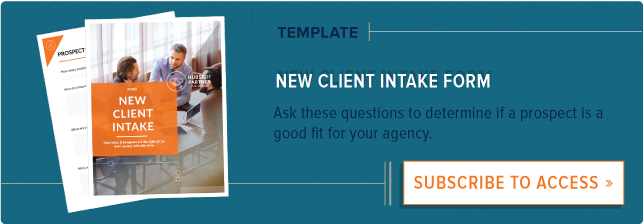It can be hard to imagine that change will actually happen.

Oftentimes, we are blind to the forces that will cause our business offerings and services to become devalued or worse, irrelevant. After all, we have to believe wholeheartedly in our agencies and what we do to be able to survive the late nights and weekend hours.
This attitude makes us vulnerable, but the future -- and we’re only talking about the next four years -- needs to be faced. The changes currently happening in the marketing industry and the needs of brands are too significant to not have an affect on the way we partner with these organizations in the future.
“Because the best marketers are increasingly looking for multiple best-in-class marketing partners -- not AOR relationships -- agencies will have to get better at playing a supporting role instead of just a ‘lead agency’ role," said Tim Williams (@TimWilliamsICG), founder of Ignition Consulting Group and aptly called the “brand doctor for brand doctors." He presents on, consults, and provides guidance on creating value in agencies, the evolution of the industry, and the challenges agency owners need to be prepared for.
“It's basic economics -- what's scarce is valuable,” Williams said. “If what you're providing in 2020 is the same as everybody else, and it's widely available, then you're not going to have a very good business. You're not going to be able to get any margins. You won't have any pricing power at all.”
Williams has created a framework for agencies to consider when transforming into an agency of the future, but first, we need a better understanding of why the current business model is facing extinction.
How Marketing Has Changed
Agencies need consider their future viability because the role of the marketer has changed significantly in the past few years. Marketers now are more concerned with:
1) Integration of a multitude of vendors, technology providers, and agencies.
According to a report from the Winterberry Group, marketers are using more than 12 different tools to manage campaigns and data, and some are using more than 31.
It’s too many different platforms and vendors and tools to 1) be proficient in, 2) manage, and 3) be able to pick out any real insights without integration of the data.
In addition, brands are maintaining relationships with multiple agencies -- sometimes up to 30 different agencies said Williams.
So much of marketers’ time is going to management of resources, rather than execution of ideas and projects. They need partners that can not only help them to streamline their workflows and tools but also are skilled in collaboration. Agencies need to get used to being one of many, and they should understand how this may impact the work they provide to clients and their communication style.
2) Sophistication in marketing technology.
Building upon the proliferation of tools is the move for marketers to become more skilled and knowledgeable about the technology platforms available. Case in point: The CMO’s tech budget is on track to rival that of the CIO’s by 2017.
“It's been fashionable for the last decade to talk about how marketers and agencies just need to get better and better at digital, which is kind of an obscure concept,” Williams said. “I think it's much more useful to define it as marketing technology.”
Marketing technology has solved many problems: tracking ROI, automation and scalability of activities, more personalized and targeted messaging for customers and prospects, integrated analytics, etc.
But there is a skills gap, and brands are confused when considering all the options available -- just look to the confusing marketing technology landscape map. It's dizzying.
“The smart agencies are going to increasingly consult on technology, help clients identify and vet the solutions that are right for them, and then go in and help them actually implement it,” said Williams.
3) Management of in-house agency and marketing resources.
By 2020, advertising as we know it will largely be redefined much more as content marketing because it's just going to have to be less intrusive,” said Williams. “It's going to have to be based on a strategy of utility. That's going to imply more journalism skills in agencies and in marketing organizations alike.”
Because of the increase in time spent on mobile devices and the adoption of ad blocking technology, advertising will be more about content and native ad experiences. And partly because of the volume of content needed and the quick turnarounds required for the pace of consumer conversations, many brands are bringing these functions in-house.
The ANA found that in 2013, 58% of brands had an in-house agency -- a 16% increase in five years. Another interesting trend is the move for brands to bring programmatic buying technology in-house. Even with the complexity of the technology, the advantages to cut costs and have more control over their own data outweighs outsourcing the program.
Agencies need to consider how to refocus and redefine their offerings to become indispensable. Production work done by an agency is easy to replace. What clients really want is strategy, ideas, and expertise. What can you offer that few others in the market can rival?
8 Foundational Elements Needed for the Agency of 2020
These changes, among many others and in addition to new competition (publishers’ content studios), have serious implications for the future of the agency model.
Williams has created a map of the foundational elements that the agency of 2020 will need to focus on. These are not focused on adding SnapChat advertising services or virtual reality production work. These foundational elements are about how agency leaders think about their service models and operate their businesses.
These are grouped into eight different areas: Expertise, Effectiveness, Agility, Pricing, Collaboration, Digital fitness, Innovation, and Accountability.

He described a few of these foundational elements in more detail:
1) Effectiveness: Agencies Will Provide Solutions, Not Just Services
Agencies believe that their business is the business of providing services to clients. But this mode of thinking is what creates a reactive and risk-adverse agency.
“The client feedback is, yeah, my agency is actually very dependable," Williams said. "They'll work weekends. They work late. They meet deadlines. They do what I ask them to do, and they work hard at it. That's pretty much all they do. They don't do anything that I didn't ask for. They don't bring me any new ideas. They don't go beyond what we request.”
This order-taking mentality is entangled in problems with the billable hour model -- where agencies don’t or can’t afford to do work that isn’t directly aligned with a timesheet entry because agencies are compensated based on inputs, not outcomes.
“Marketers have lost a lot of their respect that they used to have for agencies because they see agencies as having lost their backbone,” said Williams.
They want more push back, more risk-taking, and more proactive thinking. They can easily hire people to do the production work.
“Agencies have to wrap their heads around or least recommit to the idea that they are not in the efficiency business; they're in the effectiveness business,” he said. “No client would reasonably want to pay for efficiency. They pay for the results of our efforts.”
Clients want to see marketing results that align with the brand’s marketing and business goals. And this means agencies need to better understand business metrics around sales, revenue, customer satisfaction and retention, employee engagement, etc. We need to go beyond likes and shares and views.
In addition, agencies need to close the loop -- they have to be able to tie activities to objectives to prove their value.
2) Pricing: Align Economic Incentives of Both the Agency and the Client
“Clients are going to stop paying agencies for inputs by 2020,” said Williams.
Paying for X number of projects to be completed at X number of hours each at X dollars per hour just won’t make sense to clients. Those X hours have no value without results.
Williams pointed to the insanity of the current system: An agency makes more money by working more hours and therefore billing more hours. On the other hand, an agency makes less money if an expert solves the client's problem more quickly.
The agency wants more hours, and therefore, they are incentivized to create plans that are more complex and require more hours. On the other hand, the client wants efficiency. They want simplicity. They want expertise.
“These two are at direct odds with one another in terms of what each party wants economically,” Williams said.
Williams provides the example of Proctor & Gamble’s performance-based compensation model for its agency partners as an interesting example: 50% of compensation is based on sales, 25% is market share, and 25% is agency performance. Other agencies have linked compensation to sales, and some agencies have taken a venture capitalist/investor model for new product launches.
The goal is to line up what the client wants with what the agency wants and what the two can achieve together -- and it should have nothing to do with timesheets and hours.
“We should be looking out in the marketplace -- where value really lives -- for determining how we get compensated, not internally by counting up our costs,” said Williams.
3) Agility: Agencies Will Adopt Agile Philosophies to Improve Processes and Workflows
Another area that will define future successful agencies is how they produce work, not just what they produce.
Historically, agencies have done a poor job in this area, which may be due to the fact that once upon a time -- in the days of David Ogilvy and Bill Bernbach -- compensation was based on media commissions, not on time.
But those days are long past, and agencies need be experts in project estimating and scope management. There’s no room for mismanagement when margins continue to diminish.
The Agile methodology is one area from which we can gain inspiration for better project planning and management. It values responsiveness, usability, reduction of waste, documentation of processes, and collaboration. And its methods are more well-suited to campaign launches that happen quickly and more frequently, requiring fast turn-around times and ongoing optimization and adjustments.
The Agile methodology replaces the traditional waterfall project management technique, which was based on the idea that during the initial phase of the project, we learn everything we need to know about the project.
In reality, we learn more as we work through problems and find solutions. Scrum, a subset of Agile, values breaking projects down into smaller pieces and working in sprints (short development timeframes), learning from this, and then moving forward.
Preventing Extinction
“By 2020, in a world of increased fragmentation and specialization, agencies will have to get their business model much more focused,” Williams said. “They have to know what they stand for. They have to know where they can be best in class.”
This means defining your agency’s positioning is key -- it should be a core part of your business strategy. From this positioning and the subsequent expertise in a category, audience, or service, you can begin to address the other foundations explained in the graphic above.
The Agency of 2020 isn't that far away. It might be time to face change -- or become another casualty of disruption.











